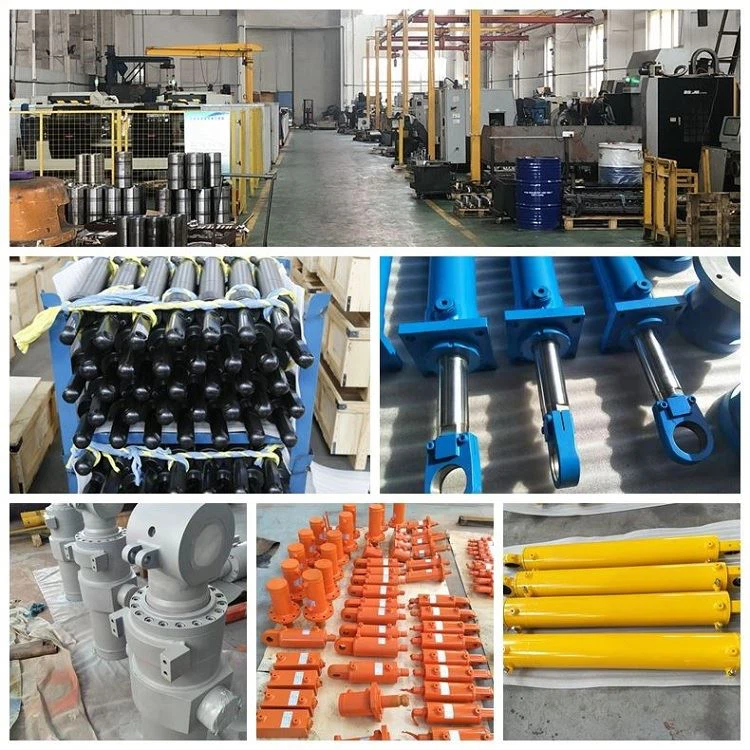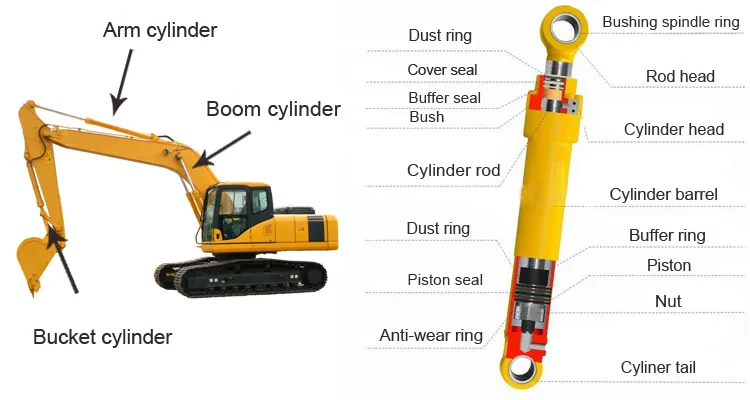Product Description
| arm boom bucket hydraulic cylinder PC30 PC35 small mini hydraulic cylinders China | |||
| Part number | Tube dia mm | Rod dia mm | Stroke mm |
| 205-63-57100 | 120 | 85 | 1285 |
| 206-63-57100 | 120 | 85 | 1285 |
| 205-63-57160 | 120 | 85 | 1285 |
| 205-63-57120 | 135 | 95 | 1490 |
| 203-63-57130 | 125 | 85 | 1120 |
| 203-63-57131 | 125 | 85 | 1120 |
| 205-63-57130 | 125 | 85 | 1120 |
Specifications
1.Supply to USA,Europe,and Australia, Russia.
2.Material:Stainless Steel
3.Professional performance excavator parts supplier
4. High quality and low price
FAQ
Q1: Are you Manufacture or Trade Company?
A1: We are manufacture,we have 20 years experience for supply Metal material and products in domestic.
Q2: How can we guarantee quality?
A2: Always a pre-production sample before mass production;Always final Inspection before shipment;
Q3: What is your terms of payment ?
A3: 1.T/T: 30% deposit in advance, the balance 70% paid before shipment
2.30% down payment, the balance 70% paid against L/C at sight
3.CHINAMFG negotiation
Q4: Can you provide Certificates for aluminum materials ?
A4:Yes,we can supply MTC-Material Test Certificate.
Q5: Can you provide sample?
A5: Yes, we can provide you sample, but you need to pay for the sample and freight firstly. We will return the sample fee after
you make an order.
| Certification: | GS, RoHS, CE, ISO9001 |
|---|---|
| Pressure: | Medium Pressure |
| Work Temperature: | Normal Temperature |
| Acting Way: | Double Acting |
| Working Method: | Piston Cylinder |
| Adjusted Form: | Switching Type |
| Customization: |
Available
|
|
|---|

How does a boom cylinder handle variations in load capacity and weight?
A boom cylinder is designed to handle variations in load capacity and weight in heavy machinery. Here’s a detailed explanation:
When a machinery equipped with a boom cylinder is used for different tasks, the load capacity and weight requirements may vary. The boom cylinder is designed to accommodate these variations and ensure optimal performance. Here are the key factors that contribute to how a boom cylinder handles load capacity and weight variations:
- Force Generation: The boom cylinder generates the necessary force to move the boom, arm, or attachment of the machinery. The force generated by the cylinder can be adjusted based on the load capacity and weight requirements. By controlling the hydraulic pressure and flow rate, the operator can regulate the force exerted by the cylinder, allowing it to handle both lighter and heavier loads.
- Adjustable Stroke Length: Boom cylinders often have an adjustable stroke length, which is the distance the piston can travel within the cylinder. By adjusting the stroke length, the cylinder can adapt to different load capacities and weight distributions. For heavier loads, a longer stroke may be required to provide the necessary extension or retraction of the boom. Conversely, for lighter loads, a shorter stroke may be sufficient, optimizing the cylinder’s efficiency.
- Pressure Compensation: Some boom cylinders are equipped with pressure compensation mechanisms. These mechanisms automatically adjust the hydraulic pressure within the cylinder to compensate for variations in load capacity and weight. For example, as the load on the boom increases, the pressure compensation mechanism increases the hydraulic pressure, ensuring consistent force and control throughout the operation.
- Integration with Load Sensing Systems: Boom cylinders can be integrated with load sensing systems that provide real-time feedback on the load capacity and weight. Load sensing systems use sensors to measure the force exerted on the boom or attachment and transmit this information to the hydraulic control system. The hydraulic control system can then adjust the pressure and flow rate to match the load requirements, optimizing the cylinder’s performance.
- Multi-Stage Cylinders: In some cases, machinery may be equipped with multi-stage boom cylinders. These cylinders have multiple sections or stages that can be extended or retracted independently. Each stage may have different dimensions and force capabilities. By adjusting the extension or retraction of each stage, the cylinder can adapt to varying load capacities and weight distributions, providing precise control and handling.
By incorporating these design features and mechanisms, a boom cylinder can effectively handle variations in load capacity and weight. This allows the machinery to perform a wide range of tasks with different load requirements, providing versatility and efficiency in industries such as construction, mining, material handling, and more.

How does a boom cylinder contribute to load distribution and control?
A boom cylinder plays a significant role in load distribution and control. Here’s a detailed explanation:
In various applications such as construction equipment, material handling machinery, and mobile cranes, boom cylinders are responsible for supporting and controlling the load. They help distribute the load forces and provide precise control over the movement of the boom or arm. Here’s how a boom cylinder contributes to load distribution and control:
- Load Support: Boom cylinders are designed to withstand and support the loads encountered during operation. They are typically mounted between the machine’s main body and the boom structure, providing a connection that carries the weight and forces of the load. The cylinder’s robust construction and load-bearing capacity ensure that the load is evenly distributed and properly supported.
- Force Generation: Boom cylinders generate the required force to control the movement of the boom or arm. By extending or retracting, the cylinder exerts force on the boom, allowing it to lift, lower, swing, or articulate as needed. The cylinder’s ability to generate and regulate force ensures precise load control, contributing to safe and efficient operation.
- Load Stabilization: Boom cylinders help stabilize the load during lifting or movement. By resisting undesired movements or vibrations, the cylinder assists in maintaining the load’s stability and preventing excessive swinging, tilting, or shifting. The controlled movement provided by the cylinder helps minimize the risk of load damage or accidents, ensuring safer and more controlled operations.
- Balance and Alignment: Boom cylinders aid in achieving balance and alignment of the load. By controlling the extension or retraction of the boom, they allow operators to adjust the position of the load relative to the machine’s center of gravity. This balancing capability helps optimize stability, prevent tipping, and enable precise positioning of the load.
- Controlled Speed: Boom cylinders enable precise control over the speed of load movement. By regulating the extension or retraction speed, the cylinder allows operators to adjust the lifting or lowering speed according to the requirements of the task. This controlled speed enhances load handling precision, minimizes impact forces, and improves overall safety.
The use of a boom cylinder in load distribution and control offers several benefits:
- Enhanced Safety: Boom cylinders contribute to load stabilization, balance, and controlled movement, reducing the risk of load accidents or instability.
- Precise Load Handling: The force generation and controlled speed provided by boom cylinders enable operators to handle loads with precision, ensuring accurate placement and minimizing the potential for damage.
- Improved Efficiency: Boom cylinders facilitate efficient load distribution and control, enhancing productivity and reducing the time required to complete tasks.
- Load Capacity Optimization: By supporting and distributing the load forces, boom cylinders help optimize the machine’s load capacity and performance.
Overall, a boom cylinder is a crucial component in load distribution and control. It provides load support, generates force, stabilizes the load, aids in balance and alignment, and enables controlled speed. These features contribute to safe, precise, and efficient load handling in various applications.
It’s important to follow the manufacturer’s guidelines and recommendations regarding the selection, installation, and maintenance of boom cylinders to ensure their proper functioning and optimal load control.

How does a boom cylinder differ from other types of hydraulic cylinders?
A boom cylinder differs from other types of hydraulic cylinders in terms of its design, function, and application. Here’s a detailed explanation of the differences:
- Design: Boom cylinders are specifically designed for heavy machinery, such as excavators, cranes, and loaders, where they are used to control the movement of the boom. They are typically larger and more robust compared to other hydraulic cylinders to handle heavy loads and withstand harsh operating conditions.
- Function: The primary function of a boom cylinder is to extend, retract, lift, and lower the boom of heavy machinery. It provides the necessary force and control to maneuver the boom for tasks such as excavation, material handling, or lifting heavy loads. Other types of hydraulic cylinders, such as single-acting or double-acting cylinders, may serve different purposes, such as linear motion control or actuation of specific machine components.
- Application: Boom cylinders are predominantly used in heavy machinery applications where the boom’s movement is critical, such as construction, mining, and material handling. They are specifically designed to meet the requirements of these industries, including the ability to handle high loads, repetitive movements, and extreme operating conditions. Other hydraulic cylinders, on the other hand, have a wide range of applications across various industries, including manufacturing, agriculture, automotive, and aerospace.
- Size and Capacity: Boom cylinders are typically larger in size and have higher load capacities compared to other hydraulic cylinders. This is because they need to accommodate the size and weight of the boom and handle the significant forces involved in heavy machinery operations. Other types of hydraulic cylinders come in various sizes and load capacities, depending on their specific application and requirements.
- Integration: Boom cylinders are often integrated into the hydraulic systems and control mechanisms of heavy machinery. They work in conjunction with other hydraulic components, such as pumps, valves, and actuators, to ensure synchronized and precise boom movements. Other hydraulic cylinders may also be integrated into different systems, but their integration and functionality may vary depending on the specific application.
In summary, a boom cylinder differs from other types of hydraulic cylinders in terms of design, function, application, size, capacity, and integration. Its specialized design and function make it suitable for controlling the movement of the boom in heavy machinery, providing the necessary force, control, and durability required for demanding applications in construction, mining, and material handling industries.


editor by CX 2023-12-12